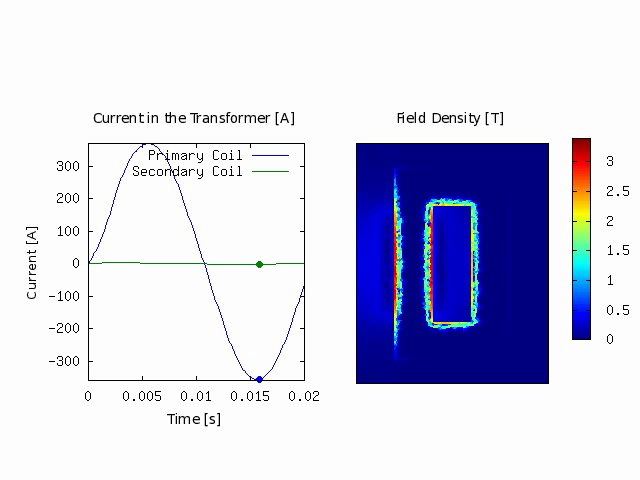Computational Magnetics
Many electro-technical devices such as e.g. printed circuit boards, electrical drives and antenna systems can be simulated on the basis of electrical circuits. However, the increasing frequencies and the decreasing size force designers to account for wave propagation effects, eddy-current effects, ferromagnetic saturation and hysteresis. For wave propagation effects and eddy-current effects, the results of stand-alone field simulation can be represented by an order-reduced equivalent model, which is then inserted in the overall circuit model. The representation of field-dependent nonlinearities and hysteresis effects, however, is not straightforward.

2D Simulation of a Transformer
The coupled field and circuit simulation becomes troublesome when a large number of time steps is required. This occurs when e.g. simulating an electrical drive where the machine requires 10 periods of 50 Hz to reach nominal speed whereas the switching of the Insulated Gate Bipolar Transistors in the frequency converter switches at 20 kHz, necessitating a time steps in the order of a microsecond to be used in the simulation. Since the field model consists typically of a few million degrees of freedom, all those unknowns have to be solved in every time step. Fortunately, the relevant time constants in electrical-energy converter are in the range 50 Hz. Hence the field model does not have to be time-stepped at the same rate as the circuit model, in which fast switches are present. The use of adaptive multirate time-integration schemes can reduce the numerical complexity of the problem substantially.
Research Questions
- Efficiency of the time-integration for field devices in pulsed circuits (multirate, dynamic iteration)
- DAE-index of the coupled system
- Existence and Uniqueness of the solution
Cooperation
- Herbert De Gersem, Katholieke Universiteit Leuven
- Markus Clemens, Bergische Universität Wuppertal
- Sascha Baumanns, Universität zu Köln
Former and ongoing projects
- Comson
- Icestars
- Sofa
